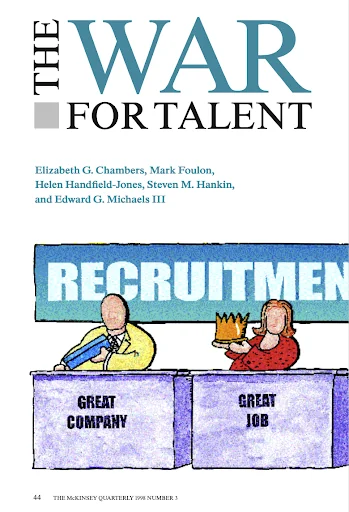Thought leadership research methods of iconic business studies
What are some of the most impactful and influential corporate studies of all time, and what were the thought leadership research methods that underpinned them? It’s a question that can help to provide a perspective on the wide range of options in use today, from the classic survey through to big data analysis, econometric indexing, and much more.

The classic survey
Published in January 1998, McKinsey’s The War for Talent changed the way businesses think about the workforce. A single sentence from the report sums up its core insight: “Companies are about to be engaged in a war for senior executive talent that will remain a defining characteristic of their competitive landscape for decades to come.” Prior to this, few reports had given much consideration to rising competition for talent. However, since its publication, few have been able to ignore the topic.

Image source: ResearchGate
While much of this study’s impact arises from the authors’ sharp analysis and explanatory powers, in-depth research underpins the findings. The authors draw on a mix of survey results and interviews with thousands of executives across 77 companies. These include respondents from the C-suite and their direct reports (359 respondents), senior executives (n=5,679), HR leaders (n=72), and interviews with a dozen independent experts. (As an aside, the researchers asked the companies to categorise the larger pool of executives into high, average or low performers – presumably on the understanding that this information didn’t get back to the executives themselves!) Each of these segmented groups was individually surveyed and analysed.
Although this led to a more complex structure than for most polls, this survey + interviews combination has dominated report study design in the past quarter-century. From Edelman’s Trust Barometer to Deloitte’s Women @ Work study, the survey has become a standard feature of corporate thought leadership research methods. But, of course, it’s not the only approach we use, as we’ll discover below.
The econometric index
You know you’ve built a successful ranking model when national governments start setting new policies, or revising existing ones, with the explicit goal of gaining a higher position on your index. Such was the impact of the World Bank’s Ease of Doing Business Index, which it launched in 2003 and has updated annually for nearly 20 years.

Image source: World Bank Group
The study was designed to measure how easy governments made it to do business in their country by gathering a large series of data points or indicators across 10 different categories, feeding into a detailed econometric index. For example, one of the ten categories in the index dealt with “Starting a business”, which included a range of sub-indicators, such as how many days it takes to set up a new business in that country (full methodology available here). As the index became widely known and used, policymakers naturally sought to improve their scores. In 2011/12, for example, 108 countries made over 200 reforms to help boost their scores. It’s hard to think of any other reports that have had this degree of influence.
Unfortunately, its huge success also led to its untimely demise. In 2021, amid allegations of data manipulation, the World Bank shut the report down. Ironically, these allegations related to senior leaders in the bank trying to pressure the Doing Business team to adjust the index methodology to boost the scores of certain countries.
But there’s no need to mourn this loss for too long. The World Bank is set to relaunch the remodelled rankings on October 3rd 2024, rebranded as Business Ready. Government officials in China are already so keen that their country performs well in the new rankings that they’ve been submitting proposed revisions to the methodology since last year.
Big data analysis
One of the big trends over the past two decades has been the rise of “big data” as a precursor to the current AI boom. And what better way into the topic of AI and work? In a 2023 study, Will AI Fix Work?, Microsoft uses its unique ability to analyse aggregate user behaviour across 365, its proprietary suite of office productivity tools, thereby tapping into “trillions of … productivity signals”.
This analysis, combined with a global survey of knowledge workers, offers insights into the breakdown of a typical working day (including the slightly depressing reality around the time we spend on Teams calls – see chart). More happily, in its 2024 report AI At Work Is Here. Now Comes the Hard Part, Microsoft shows that AI is now freeing users’ time for creative tasks.

Image source: Microsoft
LinkedIn is another proponent of big data analysis. It produces a monthly Workforce Report that analyses the hiring rate in the US market, based on which of its 214mn US-based users added a new employer to their profile in the preceding month, essentially offering real-time insights.
The expert view
An essay published in 1970 entitled The product portfolio by Boston Consulting Group founder Bruce Henderson, first brought BCG’s popular “growth share matrix” to widespread attention. This simple framework helps companies choose which products to invest in, which to ditch, and which to leave well alone. It remains in use to this day. As well as being a classic piece of consulting slideware, its enduring popularity stems from its power as a great idea from a true expert. Many thousands of other viewpoints, op-ed articles and columns are published every week, but only a tiny fraction achieve this kind of cut-through over time.

Image source: BCG
Simulating growth
Another famous piece of research from the 1970s is The Limits to Growth, commissioned by the Club of Rome and delivered by a team of MIT researchers led by Donella and Dennis Meadows. The MIT team based their study on a computer simulation of what happens when exponential population and economic growth runs up against finite planetary resources. This was based on modelling five core variables: population, food production, industrialisation, pollution and the consumption of non-renewable resources. Given the compute resources available at the time, this was, apart from anything else, a considerable technological feat. A recent 50-years-on review of the research describes it as a “methodological novelty” for the time.

Image source: The Limits to Growth; Dartmouth Collections
Although critics strongly challenged the study, its core thesis — that infinite growth on a planet with finite resources isn’t viable — has endured. (My former colleague Katy Shields recently revisited the fascinating story behind this groundbreaking research in an excellent podcast.)
From focus groups to sentiment analysis
This review features only some of the more popular thought leadership research methods used today. There are, of course, many others, and new ones emerging all the time.
At FT Longitude, we have a research innovation team that continually investigates new ways to tell stories with data. Emerging alternatives to time-honoured methods, such as the classical literature review, policy analysis and focus groups, that we’re exploring range from social media sentiment analysis through to AI-powered “data scraping”.
Could one of these new methods be a hallmark of the next most influential study to go down in history?
Sign up to the newsletter
We help organisations stand out, speak with authority and spark inspiration, so change can happen. That’s real intelligence with influence. Sign up to our newsletter to get regular updates.
Subscribe






 Back
Back

 Book a meeting
Book a meeting
 Book a meeting
Book a meeting

